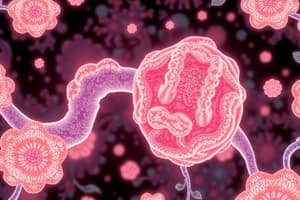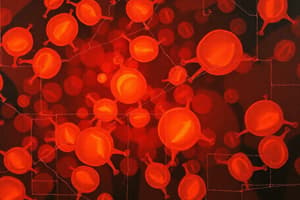Podcast
Questions and Answers
What does the term 'ACE Scanner' refer to in the given content?
What does the term 'ACE Scanner' refer to in the given content?
- A type of software used for document editing.
- A device used for scanning physical documents. (correct)
- A method for encrypting files.
- A protocol for digital image processing.
What is a primary function of the ACE Scanner?
What is a primary function of the ACE Scanner?
- To enhance the quality of printed images.
- To perform data backup for documents.
- To digitize and store physical documents. (correct)
- To edit text documents manually.
Which of the following best describes the process involved with the ACE Scanner?
Which of the following best describes the process involved with the ACE Scanner?
- Cloud backup of scanned files.
- Batch processing of files for archiving.
- Manual transcription of documents.
- Automatic recognition and digital conversion. (correct)
In what context would an ACE Scanner be most useful?
In what context would an ACE Scanner be most useful?
What advantage does the ACE Scanner provide during document management?
What advantage does the ACE Scanner provide during document management?
Flashcards
ACE Scanner
ACE Scanner
A device used for scanning documents
Scanning
Scanning
The process of converting documents into digital format
Documents
Documents
Physical records or papers containing information
Digital Format
Digital Format
A format for storing data electronically.
Signup and view all the flashcards
Conversion
Conversion
The process of changing something from one form to another
Signup and view all the flashcardsStudy Notes
MHC Class 1 and 2 Antigen Presentation
- APCs use MHC to present linear peptides to T cells.
- The MHC complex is composed of 2 alpha and 2 beta chains forming a peptide-binding groove.
- The MHC gene region on chromosome 6 is the most diverse in the genome.
- "Crossing over" (in meiosis) occurs only 2% of the time in the MHC region.
- Individuals inherit a solid block of MHC genes from each parent rather than recombined versions.
- MHC II has 5 isotypes (HLA-DQ, HLA-DP, and HLA-DR).
- MHC II α and β chains are referred to as A and B.
- Different MHC II complexes lead to varied peptide presentation.
- Variation is primarily focused on the binding groove of the β chain.
- APCs take up proteins/antigens and break them down into smaller linear peptides.
- Proteases are used to degrade 3-D protein into linear peptides.
MHC II Complex Function
- The invariant chain blocks the peptide-binding groove in the MHC II complex until the antigen is processed.
- The invariant chain is removed, and the binding groove is available for peptides.
- HLA-DM facilitates the peptide exchange for CLIP (class II associated invariant chain peptide).
MHC I Complex Function
- MHC I has one heavy chain and Beta 2 microglobulin.
- It exhibits peptide-binding groove variability.
- MHC I complex in ER needs an escort to transport peptides into the complex
- Chaperone proteins (like Calnexin) assist the MHC I assembly process
- A peptide delivered by TAP binds to the heavy chain to form the mature MHC I molecule.
- MHC I complex then exports from ER to cell surface.
- ERAP enzyme removes N-terminal amino acids of peptides to make the peptides 8-10 residues.
T Cell Interaction with MHC
- MHC I interacts with CD8 T cells.
- MHC II interacts with CD4 T cells.
- CD8 T cells check cells for intracellular organisms.
- CD4 T cells need co-stimulation for proliferation/ activation.
- CD8 T cells directly kill infected host cells.
Mechanisms of Cellular Killing
- Granules in CD8 T cells contain perforin to create pores in target cells.
- Granules also contain granzymes that enter the pores to initiate apoptosis.
NK Cell Function
- NK cells detect MHC I on healthy cells, killing cells lacking MHC I.
- Activating receptors on NK cells recognize stress proteins on infected cells.
- Inhibitory receptors check MHC I presence.
Studying That Suits You
Use AI to generate personalized quizzes and flashcards to suit your learning preferences.




